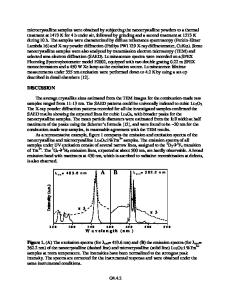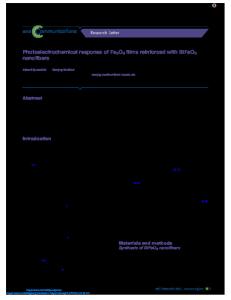Influence of Pr 3+ and Lu 3+ co-doping on the magnetoelectric coupling response in BiFeO 3 mutiferroic ceramics
- PDF / 3,538,400 Bytes
- 7 Pages / 595.276 x 790.866 pts Page_size
- 32 Downloads / 306 Views
Influence of Pr3+ and Lu3+ co‑doping on the magnetoelectric coupling response in BiFeO3 mutiferroic ceramics Amit Kumar1 · Sandeep Saini2 · K. L. Yadav2 · Naveen Kumar3,4 · Sanjeet Kumar1 · Satyendra Singh1 Received: 10 May 2020 / Accepted: 22 July 2020 © Springer Science+Business Media, LLC, part of Springer Nature 2020
Abstract Perovskite-type bismuth ferrite (BiFeO3) multiferroic material is being considered as a potential candidate for magnetoelectric coupling and field-controlled multi-state memory applications. We report the P r3+ and L u3+ co-doping effect on the magnetoelectric coupling in BiFeO3 ceramics. In this study, Bi0.94Pr0.06FeO3 (BPO), Bi0.94Lu0.06FeO3 (BLO), and Bi0.94Pr0.03Lu0.03FeO3 (BPLO) ceramics were synthesized by conventional solid-state ceramic synthesis technique. The BPO sample displayed higher saturation magnetization as compared to BLO and BPLO samples which may be due to canting of spin cycloid of BFO and also due to the discrepancy between the antiparallel sublattice of Fe3+/Fe2+, the value of ferroelectric polarization of the BPO sample was found to be better than BLO and BPLO samples. However, the magnetocapacitance (MC) of the BPLO sample is found to be MC ~ 2.3% which is higher than that of BLO (MC ~ 1.4%) and BPO (MC ~ 1.7%) samples. In addition, the enhanced value of magnetoelectric coupling coefficient (αE) has been obtained for the BPLO sample. Overall, our results indicate that BPLO sample displays interesting magnetoelectric response for device applications.
1 Introduction In the last decade, magnetoelectric materials have received a great attention due to their promising applications in various devices, such as transducers, sensors, and information storage devices [1–4]. Magnetoelectric materials display a magnetoelectric (ME) coupling between their spins and electric dipoles, which is a promising feature for device designs by controlling magnetization with electric fields, or contrariwise polarization with magnetic fields. Recently, perovskite structured B iFeO3 (BFO), a mutiferroic material has been studied for magnetoelectric coupling [4–6]. BFO mutiferroic material shows the ferroelectric Curie transition temperature and the antiferromagnetic Neel transition temperature above the room temperature (TC = 1103 K and
* Satyendra Singh [email protected] 1
Special Centre for Nanoscience, Jawaharlal Nehru University, New Delhi, India
2
Department of Physics, Indian Institute of Technology Roorkee, Roorkee, India
3
Punjab Engineering College (Deemed To Be University), Chandigarh 160012, India
4
Sri Guru Gobind Singh College, Chandigarh 160019, India
TN = 643 K) [7]. Single-phase BFO shows a rhombohedral structure with the space group of R3c at room temperature. Synthesizing single phase BFO is a challenging job, because in general case secondary phases form along with the main perovskite phase. The secondary phase (Bi2Fe4O9) increases the conductivity of BFO. Therefore, researchers have tried to prevent the formation of the secondary phas
Data Loading...











